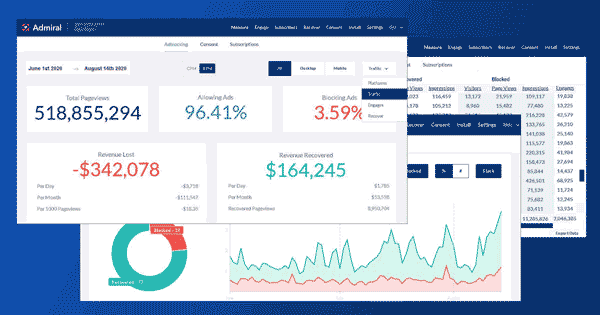More than 73 million people in the U.S. are using some form of ad blocker when online – more than 26% of all internet users. It costs publishers billions of dollars in ad revenue each year. Estimates range from $12 billion in lost revenue in 2020 to $40 billion. Not only does ad-blocking technology prevent ads from showing (costing publishers money), but it can also disrupt or block Google Analytics from collecting data and tracking site visitors.
The majority of ad blockers have options to block Google Analytics (GA) and block attempts from the GA JavaScript library to send or retrieve data from analytics servers. Some adblockers block Google Analytics by default.
When adblockers are deployed by users, it can cost publishers up to a quarter of all their web traffic. It’s not that the traffic suddenly disappears, but in addition to a publisher's ads being blocked, the data from these visitors may not show up in web analytics. It can mean your quantitative metrics, such as page views, duration, bounce rate, and conversion rates can all be rendered inaccurate.
Mobile ad blockers are particularly troublesome for publishers wishing to stop adblock losses. Most block web analytics by default by preventing communication with domains that are ad-supported. That can mean losing all data from mobile visitors. Not all desktop browser extensions block ads by default, but many do. Even if it’s not done automatically, most can block tracking and Google Analytics with a single click.
The problem for publishers is only getting worse. Firefox added private browsing and tracking protection in 2015. Other browsers followed suit. Ad blockers and Analytics blockers are easy to find on the Chrome web store. Even Google has its own opt-out extension blocking information from being collected by Google Analytics. It’s not so easy to find adblock analytics that can detect adblock and show you how much revenue is blocked by ad blockers.
Most adblockers rely on signals, such as sites setting third-party cookies, browser fingerprinting, or so-called supercookies inserted in HTTP headers to collect data. Google Analytics also gathers data by cookie sharing – a way to access cookies set by other sites and attribute them to users.
How to Recover
Revenue Lost to Adblock
There are some complex workarounds you can implement to handle analytics blocked by adblockers, such as using proxy servers and some misdirection or hosting (and modifying) GA on your domain. It can be intense tech work for web teams, is not recommended by the Google Analytics team, and it may be obsolete by the time it’s deployed. Staying on top of evolving changes in anti-adblocking and analytics can take up a lot of time. On top of that, managing privacy regulations can be time-intensive as well.
Many smaller or lean publishing teams – with big audiences – may not have the tech team or expertise to stay on top of the latest trends and adapt rapidly as things change to stop adblock losses.
There’s a much easier way to make sure you get the data you need and unlock visitors to view your full ad stack.
Admiral, The Visitor Relationship Management (VRM) Company, can help publishers recover their lost ad revenue from adblockers. We provide publishers with advanced AdBlock analytics that Google cannot – and it's free!
This can show you how much money you’re losing and track block rates to your site. All of our free signups get AdBlock analytic statistics for their site by just adding one tag. (Request your tag here to immediately track impact)
We detect adblock technology to provide the industry's best adblock analytics and revenue recovery toolset, including:
- Max CPM Whitelist-based revenue recovery to unlock your full ad stack
- Ad-reinsertion recovery, including the combo of reinsertion plus whitelisting
- Alternate value exchanges to turn adblockers into paying subscribers, social followers, and more
- Superior ad block detection
- Analytics tools and dashboards to target unlimited segments
- AI-powered surge and popularity targeting to maximize whitelist conversions
For more information, FAQ, and best practices, see our comprehensive Adblock Revenue Recovery Guide.
See Admiral's Full-Stack Adblock Recovery in Action
See how Admiral has unlocked revenue for publishers just like you, and get a free calculation of your potential returns based on your traffic and content vertical.





